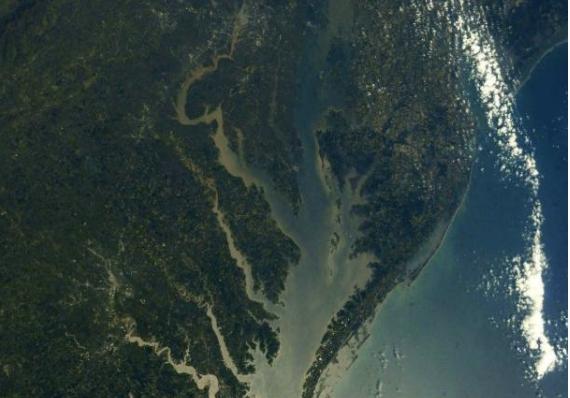“Heaven and earth never agreed better to frame a place for man’s habitation….”
John Smith, 1608
Impressions, dreams – they are the forces of imagination and ultimately ambition. John Smith, an early leader in the European discovery of the Chesapeake Bay, had his impressions, which ultimately shaped European ambitions.
The Eastern Shore Land Conservancy (ESLC) four centuries later has its dreams and has translated them into a two word ambition called Delmarva Oasis. It is looking back 400 years and then using history and technology as it offers us a vision.
Rob Etgen, the President of ESLC, and I recently shared thoughts about the Bay and its watershed in a wide-ranging conversation. Here are my impressions.
 The descriptive, oasis, is an interesting word. It is often associated with a desert landscape – it is the fertile relief. In a sense, the Chesapeake Bay and its tributaries surround fertility – the Delmarva Peninsula. The Bay’s oasis started out as woodlands and then farms and fishing villages and inevitably was discovered by business. Natural beauty and diversity were magnets for capital.
The descriptive, oasis, is an interesting word. It is often associated with a desert landscape – it is the fertile relief. In a sense, the Chesapeake Bay and its tributaries surround fertility – the Delmarva Peninsula. The Bay’s oasis started out as woodlands and then farms and fishing villages and inevitably was discovered by business. Natural beauty and diversity were magnets for capital.
Capital investment doesn’t prefer boundaries; it searches out demand and supplies it. Small-scale farming yielded to commodity crop supply, and tourist demand to a full array of transportation and service industry companies. Cumulatively these forces depleted nature’s gift; economists call this the tragedy of the commons. The tragedy: the totality of individual actions according to their own self-interest behave contrary to the common good of all users. No statistic underscores this dynamic more than a 90% decline in the number of oystermen from the historical high.
History tells us what our watershed used to be and reality tells us what it is. The overriding question today is up to our imagination – do we envision a different future and if so, what?
ESLC is helping us define the future; it is going beyond criticisms of the present. It is providing a hopeful narrative – an organizing principle.
ESLC is not without preferences. It wants to preserve buildings that both have character and were important building blocks in our history. In Easton it bought and saved a handsome old laundry; it is now a conservation center. Its centrality offers a crucial 21st Century building block. It is a center of environmental activity. Environmental organizations are just across the hall from one another and the common areas invite community and collaboration.
All of us dream – few plans follow and even fewer plans become operational without partnerships. A 21st Century oasis around which the waters of the Bay and its tributaries circumnavigate will require collaboration.
I enjoyed being an early part of what became ShoreRivers and I know the good work they are doing. We are blessed with strong environmental leadership and ESLC’s goals for our watershed envision a coalition of interests. Each will remain distinct, but by contributing to the 21st Century restatement – Delmarva Oasis – the overall fertility of our precious piece of land will be enhanced.
Renewal stands beside preservation in ESLC’s vision – a renewal of nature as our ally. I am reminded of New York City’s much praised tap water. The City protected the springs, creeks and rivers that fill its reservoirs; it didn’t need to build and maintain the kind of treatment systems required when water sources are allowed to be polluted. And, make no mistake the quality of the water in our drainage basin is an essential asset – it is a crucial element in nature’s sustenance.
Let me end by turning back to farms and businesses. The Eastern Shore has been vastly changed since John Smith sailed up its coasts. Plans must comprehend the present. ESLC and its partners will need to build a true coalition and that is hard work and not everybody will sign on. Indeed, if everybody did, preservation and renewal would be attenuated. But, thank goodness for ESLC, its dream and leadership gives us a better chance that our ancestors will say thank you.
John Smith was, in today’s terms, a globalist. Today, Covid 19, reminds us of place—where we live and the neighbors that fill our lives with choices and support. On this Earth Day we should re-dedicate ourselves to the only earth we can really influence—our own.



Write a Letter to the Editor on this Article
We encourage readers to offer their point of view on this article by submitting the following form. Editing is sometimes necessary and is done at the discretion of the editorial staff.